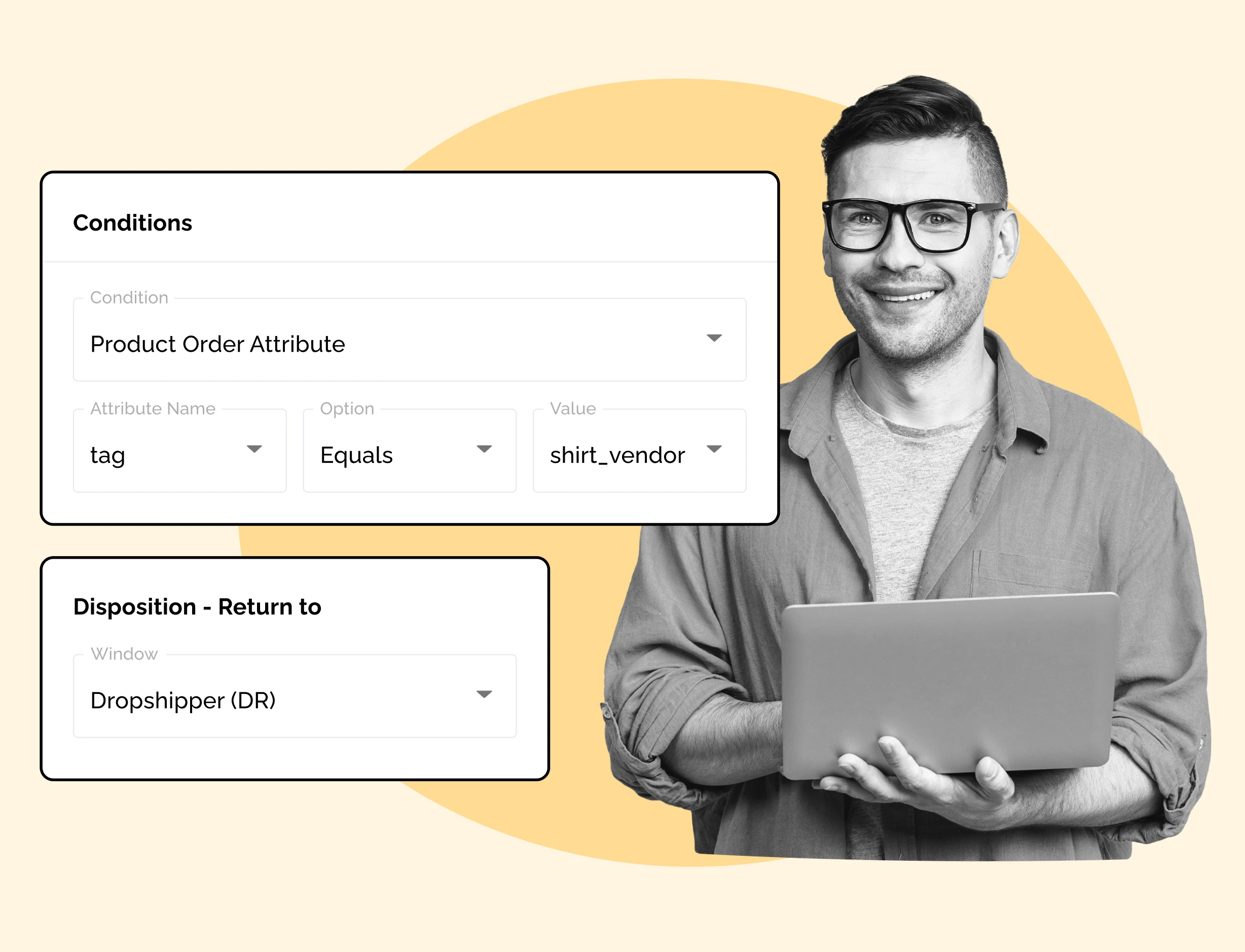Mastering Tracking in Ecommerce: The Ultimate Guide for Success
Let’s explore how tracking systems can enhance customer satisfaction, improve operational efficiency, and provide valuable business insights!
Shipping, Tracking & Notifications
Boost customer experience and reduce support tickets
Realtime order and shipment tracking
Proactive order and shipping notifications
AI-Enhanced Discounted Labels
Predictive pre-purchase estimated delivery dates
Self-Serivce branded order tracking
Effortless experience delivered
Identify and Resolve Order Issues
Realtime order and shipment tracking
Make returns profitable and delight customers
Flexibility to define any return destinations & conditions
Simplify returns for your customers and team
Incentivize exchanges over returns
Returns management made easy for your team
Returns management made easy for your team
Easy claims and smart upsells
Understand why your customers are returning
In-Store & Curbside Pickup
Unify the online and the in-store experience
Hassle-free pickup experience for customers
In-Store dashboard to keep operations streamlined
In-Store and Online orders unified
Drive foot-traffic to your stores
Shipping, Tracking & Notifications
Boost customer experience and reduce support tickets
Realtime order and shipment tracking
Proactive order and shipping notifications
AI-Enhanced Discounted Labels
Predictive pre-purchase estimated delivery dates
Self-Serivce branded order tracking
Effortless experience delivered
Identify and Resolve Order Issues
Realtime order and shipment tracking
Make returns profitable and delight customers
Flexibility to define any return destinations & conditions
Simplify returns for your customers and team
Incentivize exchanges over returns
Returns management made easy for your team
Returns management made easy for your team
Understand why your customers are returning
In-Store & Curbside Pickup
Unify the online and the in-store experience
Hassle-free pickup experience for customers
In-Store Dashboard to keep operations streamlined
In-Store and Online orders unified
Drive foot-traffic to your stores
Boost customer experience and reduce support tickets
Realtime order and shipment tracking
Proactive order and shipping notifications
AI-Enhanced Discounted Labels
Predictive pre-purchase estimated delivery dates
Self-Serivce branded order tracking
Effortless experience delivered
Make returns profitable and delight customers
Flexibility to define any return destinations & conditions
Simplify returns for your customers and team
Incentivize exchanges over returns
Returns management made easy for your team
Equip your team for precise return checks.
Easy claims and smart upsells
Understand why your customers are returning
Unify the online and the in-store experience
Hassle-free pickup experience for customers
In-Store Dashboard to keep operations streamlined
In-Store and Online orders unified
Drive foot-traffic to your stores
Find the answer to all your questions
Take a step by step trip through our functionality to see how we can improve your ecommerce processes.
Explore the most comon questions about WeSupply
Calculate the ROI that WeSupply can bring you
Read actionable articles on how to optimize your post-purchase experience and decrease support tickets
Get inspired by stories of how our customers implemented an effortless post-purchase experience
Wondering if WeSupply is a good fit for you? Read through our use cases to see how we can help you increase conversion & improve CX!
A Deep Dive into Top Companies' Order Tracking & Returns Strategy
Find the answer to all your questions
Explore the most comon questions about WeSupply
Calculate the ROI that WeSupply can bring you
Request a no strings attached review of your current shopping experience and missed conversion opportunities
Take a step by step trip through our functionality to see how we can improve your ecommerce processes.
Read actionable articles on how to optimize your post-purchase experience and decrease support tickets
Get inspired by stories of how our customers implemented an effortless post-purchase experience
A Deep Dive into Top Companies' Order Tracking & Returns Strategy
Wondering if WeSupply is a good fit for you? Read through our use cases to see how we can help you increase conversion & improve CX!

Managing dropshipping returns requires clear, actionable strategies. This article goes straight to the point, offering you practical steps to design a customer-friendly returns policy, coordinate with suppliers, and leverage technology to streamline these occasional but inevitable challenges. Get ready to turn dropshipping returns into a source of customer trust rather than frustration.
Managing returns and refunds in dropshipping is complex, requiring alignment with varied supplier policies and efficient management to ensure customer satisfaction and maintain business reputation.
A well-crafted and transparent return policy is essential for a dropshipping business, outlining clear instructions on the return window, who pays for return shipping, and the return process, ensuring consumer confidence and reducing disputes.
WeSupply streamlines dropshipping returns by automating processes, supporting unlimited dropshippers, and offering customizable return policies. Key features include flexible return windows, insightful analytics, self-service returns, QR code labels, and proactive customer communication. Simplifying refunds and handling damaged items efficiently, WeSupply enhances customer satisfaction and operational efficiency. Get started with WeSupply to optimize your returns management.
Dropshipping has revolutionized the way entrepreneurs approach online retail. Unlike traditional ecommerce businesses, a dropshipping store doesn’t require you to hold any inventory. Instead, when a customer makes a purchase, the product is sourced from a third party—often a dropshipping supplier—who then ships it directly to the customer. This business model allows you to focus on marketing and customer service while the logistics are handled by the suppliers.
One of the most significant benefits of running a dropshipping business is the reduced upfront costs. Without the need to invest in inventory, you can start an online store with minimal capital. Additionally, dropshipping offers unparalleled flexibility. You can operate your business from virtually any location and easily adapt your product offerings based on market trends. This flexibility also extends to multi-channel selling, allowing you to reach customers across various platforms, including your personal website, Amazon, and social media channels.
Another advantage is the ability to offer a broader range of products without the constraints of physical inventory. This not only enhances your product catalog but also allows you to test different products in the market with minimal risk. However, it’s essential to acknowledge that this model requires a well-thought-out approach to handling returns and refunds to maintain customer satisfaction and loyalty.
Dropshipping is a retail fulfillment method where the store doesn’t keep the products it sells in stock. Instead, when a store makes a sale, it purchases the item from a third party and has it shipped directly to the customer. This means that the store owner doesn’t have to handle the product physically, allowing them to focus on other aspects of the business like marketing and customer service.
In a dropshipping business model, the seller of record is the entity that is identified as the seller to the end consumer, assuming responsibility for sales tax and setting product prices. This model has gained popularity due to its low upfront costs and the ability to offer a broad range of products without the need for inventory investment. However, the trade-off is that you have less control over product quality and delivery times.
The process typically involves the online retailer acting as a middleman. They take customer orders and payments, which are then passed to the dropshipping supplier for direct shipping to the customer. This setup allows business owners to operate an online store without the complexities of traditional inventory management, but it also requires a robust strategy for handling returns and refunds to ensure smooth operations and customer satisfaction.
One of the foremost advantages of running a dropshipping business is its low barrier to entry. Unlike traditional ecommerce models that require significant investment in inventory and warehousing, dropshipping allows entrepreneurs to start an online store with minimal capital. This makes it an attractive option for those looking to dip their toes into the online retail world without the financial risk.
Flexibility is another key benefit. Dropshipping businesses can be operated from virtually any location, allowing owners to manage their stores while traveling or working from home. This model also supports multi-channel selling, enabling you to reach customers across various platforms, including your website, Amazon, and social media.
Additionally, dropshipping allows for quick scalability. Since you are not limited by physical inventory or warehouse space, you can easily expand your product range and adapt to market trends.
Furthermore, dropshipping offers the following benefits:
Reduces the burden of inventory management
Suppliers handle product storage, packaging, and shipping
Business owners can focus on marketing and customer service
Allows for a broader product offering without the risk of unsold inventory
However, to fully capitalize on these benefits, it’s crucial to have a well-defined strategy for managing returns and refunds to maintain customer satisfaction and loyalty.
While dropshipping offers numerous advantages, managing returns and refunds can be particularly challenging. The complexity arises from dealing with multiple suppliers, each with their own return policies and processes. This can make it difficult to standardize the return process and ensure a seamless experience for customers. Additionally, the lack of control over the fulfillment process means that retailers have to rely on suppliers to handle returns efficiently, which is not always guaranteed.
The impact on customer experience cannot be understated. Efficiently managing returns and refunds is crucial for maintaining customer satisfaction and loyalty. A poor returns process can lead to negative reviews, decreased customer loyalty, and ultimately, lost sales. Therefore, it’s essential to have clear policies and effective strategies in place to handle returns and refunds in a dropshipping business.
Dropshipping returns are inherently more complex than those in a traditional ecommerce business due to the involvement of multiple suppliers and varying return policies. Each supplier may have different requirements for accepting returns, such as specific return windows or conditions, adding layers of complexity to the process. This necessitates centralized management of returns, generation of carrier-compliant return shipping labels, and adherence to supplier-specific return policies.
Different types of returns require tailored approaches to handle efficiently. Some common types of returns include:
Wrong product or size
Products not matching descriptions
Damaged items
Late delivery
Incorrect items
For example, a return due to a damaged item may involve different steps and communication compared to a return for an incorrect size. Utilizing technologies like self-service return centers can help streamline these processes by allowing customers to initiate returns and track their progress.
To manage dropshipping returns effectively, retailers need to:
Understand the reasons behind returns and implement efficient strategies.
Create a well-defined return policy that outlines eligibility conditions, return solutions, time frames, and instructions.
Streamline communication with suppliers to understand their individual return policies, including any fees and preferred methods for handling returns.
Set up automated return portals that cater to different conditions and policies of various suppliers to simplify the return process.
WeSupply offers a comprehensive solution to address the challenges in dropshipping returns and refunds. By utilizing our Intelligent Disposition functionality, you can seamlessly return products to their respective dropshipping vendors while using WeSupply as the central hub for managing all dropshipping returns. This ensures a streamlined and efficient process, even when working with multiple vendors.
Key features include:
Creating a clear and effective return policy is paramount for any dropshipping store. A well-drafted return policy not only helps avoid disputes with customers but also maintains the store’s reputation. It should be prominently displayed on your website, providing details on return windows, return addresses, and return shipping fees.
This transparency enhances consumer confidence, which can lead to increased sales as customers are more likely to shop from a store with well-defined return information.
A transparent return policy is crucial for any dropshipping business. It enhances consumer confidence, leading to increased sales, as customers are more likely to buy from a store with well-defined return information. Having a publicly posted and legally binding return policy is essential, as it outlines the terms for cancellations, returns, and refunds, which can differ significantly between dropshipping companies. Certain laws may require businesses to accept all returns within a specified period if they do not have their own publicly available return policy.
Providing a return policy in simple, understandable language and displaying it prominently can help reduce uncertainty for online shoppers. This not only streamlines ecommerce operations but also raises the professionalism of your store. A clear and customer-centric return policy is crucial for building trust and encouraging repeat business.
An effective return policy should include the following:
Clearly state the time frame customers have to return items and under what conditions
Specify who bears the cost of return shipping, whether the dropshipping store or the customer
Provide a straightforward and easy process for initiating a return
Explicitly mention any terms regarding the condition of returned items, such as requiring items to be in original packaging
Including a FAQ section for your return policy can help address common customer questions and concerns, facilitating a smoother return and refund experience. When dealing with international returns, it is crucial to clarify who is responsible for additional shipping costs and customs fees and to set reasonable return windows due to longer shipping times.
A well-crafted return policy should state which products are eligible for returns, the return process, who pays for return shipping, and the type of refund issued.
Crafting a winning return policy for your dropshipping store is essential for customer satisfaction and operational efficiency. WeSupply’s Pre-built Return Policies streamline the process by automating returns, ensuring products are returned directly to the appropriate vendor or dropshipper without manual intervention. This reduces handling time, minimizes errors, and enhances customer satisfaction, leading to cost savings and increased profitability.
Some examples of dropshipper-orietented policies include:
By leveraging WeSupply’s Pre-built Return Policies, you can streamline your dropshipping return process, enhance customer satisfaction, and boost your store’s profitability. Explore our other solutions to further optimize your returns management and elevate your business to new heights.
Defining a clear return window and process is essential for managing returns smoothly. Automating the return process using tools like Shopify apps can help make it easy for customers to initiate returns and track progress, reducing the workload on the business owner.
A standardized return policy template can ensure consistency and fairness in the return process. Additionally, providing a comprehensive fraud policy can protect the dropshipping business from fraudulent return activities.
Aligning your store’s return policy with your suppliers’ policies is crucial for a seamless return process. Dropshipping store owners must have a grasp of their suppliers’ return policies to effectively handle returns in the background. It’s important to consider the return policies of all suppliers being used, as they may differ, to create a consistent return policy for the store.
The return policy of the dropshipping store should not be a direct copy of the supplier’s policy but rather be based on it, ensuring that it matches in terms of return windows and conditions.
WeSupply simplifies the process of defining return windows, ensuring clarity and flexibility for both customers and your team. By offering multiple return window options, WeSupply eliminates confusion and unwanted returns, adapting to various scenarios to maintain control over the return process.
Key features include:
Implementing these features can enhance customer satisfaction and streamline your return management system. Ready to streamline your returns process? Book a demo with WeSupply today and see how our features can transform your business!
Simplify Returns for Your Customers and Support Team
Book a quick call with our experts to see how WeSupply can help you: simplify the Return experience with just a few clicks, reduce customer service calls and manual processing, notify your customer about their refund, automate returns and reduce user error
Understanding common reasons for returns can help in managing them more effectively. Many ecommerce returns are due to customers receiving products that are damaged, defective, or different from what is described, leading to dissatisfaction and return requests. Shipping delays or errors are a frequent reason for returns in dropshipping, as they cause frustration when orders do not arrive as expected.
Inaccurate product descriptions or misleading advertising also contribute significantly to return rates in dropshipping.
WeSupply’s Returns Analytics provides valuable insights into common reasons for returns, helping you improve your product offerings. By examining SKU-level analytics, you can quickly identify return reasons at the product and variant level, such as color, quality, and size. Understanding these patterns allows you to address customer dissatisfaction more effectively, refining your inventory and enhancing overall satisfaction.
Key features include:
Leverage these insights to make data-driven decisions and better meet your customers’ needs.
Managing return shipping costs is a critical aspect of handling dropshipping returns efficiently. The dropshipping return process involves several steps:
The customer initiates a return request, which can be done via email, chat, or a form on the online store platform.
After receiving a return request, the seller should promptly respond, apologize for any inconvenience, and inform the customer about the specifics of the return policy, including any restrictions on returnable items.
The seller must then instruct the customer to send the product back to the return address provided.
Once the item is returned, the seller needs to decide whether to offer the customer a replacement for the returned product or issue a refund.
Assessing the reasons behind returns is crucial for determining the appropriate solutions. Common reasons for returns in dropshipping include ordering the wrong product or size, product mismatches with its description, receiving damaged or defective items, products arriving late, or the customer receiving the wrong item. Solutions for returns may involve providing incentives to exchange products, correcting product descriptions, compensating for defective products, providing delivery estimates and updates, and rectifying errors in fulfillment. Clear communication about who will bear the return shipping costs is crucial in a dropshipping return policy.
The dropshipping return process starts with the customer initiating a return request. After a return request, the seller should verify the details of the request and respond promptly. The seller may choose to:
First receive the item themselves to verify the issue
Buy a return label for the customer to send the item directly to the supplier
Ask the supplier to provide a return label to the customer
The most efficient and cost-effective method for handling returns is asking the supplier to provide the return label directly to the customer for the return shipment.
Once the item is returned, the seller needs to decide whether to offer the customer a replacement or a refund. This decision should consider factors such as item value and the cost-effectiveness of the return process. Providing clear instructions and maintaining open communication throughout the process can help ensure a smooth return experience for the customer.
Understanding the reasons behind returns is essential for managing them effectively. Common return reasons include receiving a damaged product, the wrong item, or an incorrect order. By analyzing return data, businesses can identify frequently returned products and the reasons behind them, providing insights to reduce future return rates. Solutions for returns may involve providing incentives to exchange products, correcting product descriptions, compensating for defective products, providing delivery estimates and updates, and rectifying errors in fulfillment.
It’s vital for dropshippers to comprehend their suppliers’ return policies to effectively manage their own return processes. Clear communication about who will bear the return shipping costs is crucial in a dropshipping return policy. Analyzing whether it is more cost-efficient to request a product return to the supplier or to send a replacement directly to the customer can help in managing return costs.
Effective return handling requires:
Prompt responses to customer queries
Clear communication of return policies
Maintaining polite communication with both suppliers and customers throughout the return process
Streamlined communication with suppliers to understand their return policies and coordinate on how returns are processed, including any potential restocking or shipping fees.
These practices are crucial for preserving relationships and ensuring a smooth return experience.
Using automated return management systems can help track returns, update customers, and manage shipping labels and fees. This not only enhances customer satisfaction but also improves the efficiency of the return process. Maintaining a positive and professional relationship with both customers and suppliers throughout the return process is crucial for a successful dropshipping business.
WeSupply simplifies addressing return shipping costs and handling returns efficiently by acting as the central hub for all your dropshipping returns. With Intelligent Disposition functionality, each product can be automatically returned to the original dropshipping vendor. Key features include:
Customers can easily access the return policy on the order lookup page, which allows them to search for orders by inputting the order ID and email address, facilitating seamless return initiation.
Plus, WeSupply integrates with a wide range of third-party tools, apps, and carriers, providing smooth data transfer and improved customer experience.
WeSupply’s pre-built return policies simplify offering free returns and exchange incentives, enabling businesses to:
Incentivize exchanges over returns by providing instant store credit, increasing average order value
Reward customers opting for store credit instead of refunds
Redirect customers to the product catalog after initiating returns
Promote exchanges and credit coupons to increase profits
Simplifying the return request workflow is essential for managing returns efficiently. Implementing a well-defined return policy assists in streamlining the returns management process. A clear return policy plays a crucial role in setting customer expectations and enhancing their confidence in making purchases.
Aligning your policy with the return policy of the suppliers and offering the same return arrangement for all products, regardless of different supplier policies, can simplify the process.
Using a return management system can streamline the return process and enhance customer satisfaction. Automating updates and tracking returns can reduce errors and improve efficiency. Such systems can also lead to cost savings, as it may be more economical in some cases to issue a refund without a return for low-cost items, benefiting both the customer and the business.
WeSupply offers a comprehensive Return Management System that enhances customer satisfaction and streamlines operations. Key features include:
Branded returns portal: Boost customer loyalty with a seamless, omnichannel experience, avoiding confusing third-party pages.
Self-service returns process: Save time by giving shoppers complete control over the return process, meeting the 70% of customers who seek a frictionless returns experience.
Flexible returns rules: Tailor policies to various use cases, eliminating restrictive limitations.
Autogenerated QR code return labels: Simplify returns by removing the need for printing, allowing customers to return items easily by scanning a QR code from their email.
Returns tracking: Enable customers to monitor their returns effortlessly, tracking progress and checking status with just a few clicks.
Post-purchase email and SMS notifications: Keep customers informed and engaged with high open rates, sending return shipping notifications and personalized deals.
By implementing WeSupply’s comprehensive Return Management System, you can significantly reduce costs and improve ROI through efficient return handling and enhanced customer satisfaction. Discover how much you can save by using our ROI Calculator today!
Utilizing automated return systems can greatly improve the efficiency of handling returns in a dropshipping business. Some benefits of automated dropshipping include:
Streamlining the order and return processes
Quickly notifying suppliers about customer orders for faster fulfillment
Processing returns more efficiently
By implementing automated dropshipping, you can save time and provide better customer service.
WeSupply’s automated return systems enhance efficiency, reduce errors, and minimize costs, providing significant advantages for your business. Key features include:
Streamline the returns process: Automatically calculate restocking fees, apply vendor-specific policies, and prevent return fraud by identifying and stopping abusers.
Reduce returns fraud rate: Protect your business by minimizing fraudulent return activities.
Minimize RMA cost: Save time and money by avoiding mistakes and streamlining the returns process from automation to minimizing touchpoints, including returns, exchanges, reshipments, and warranties.
Inspect returns and manage inventory better with restocks: Implement quality control by inspecting returns, collecting customer feedback, and allowing warehouse staff to leave notes on each return.
By leveraging WeSupply’s automated return systems, you can streamline your returns process, reduce costs, and enhance overall efficiency. Ready to transform your returns management? Book a demo with WeSupply today and see the benefits firsthand!
The case of Auto Rim Shop illustrates the successful implementation of automated systems in the dropshipping return process. By partnering with WeSupply, Auto Rim Shop was able to automate returns and streamline operations, resulting in cost savings, faster returns processing, and a better customer experience. The collaboration allowed Auto Rim Shop to set up customized return rules, automated return label generation, and intelligent dispositions to save on transportation costs.
WeSupply’s features that contributed to a better post-purchase experience for Auto Rim Shop include:
Split shipment visibility
Real-time updates on orders
Automated order tracking
Returns management tools
The implementation of WeSupply resulted in a significant reduction in customer support tickets and improved customer satisfaction scores for Auto Rim Shop. Read the full case study!
Effective coordination with dropshipping suppliers is essential for managing returns smoothly. Open communication with suppliers is necessary to understand their return policies, as each supplier may have different approaches to managing returns.
Ensuring clear communication with suppliers is crucial in managing the dropshipping returns process effectively.
Understanding your supplier’s return policy is vital for managing your store’s return process. Dropshipping retailers should inquire about their suppliers’ restocking or shipping fees for returns and understand how they prefer to handle the returned products.
A Return Policy should detail the time frame for returns, who covers return shipping costs, the process for initiating a return, the condition of returned items, and any restrictions on returns.
Negotiating better return terms with suppliers can improve the efficiency of managing returns. Dropshippers should seek to align their return policies with those of their suppliers while providing ample time for customers to initiate returns.
Clear return policies created in collaboration with suppliers can streamline and accept returns, enhancing customer satisfaction.
Effectively managing refunds and offering store credits are crucial aspects of handling returns in a dropshipping business. A clear refund process and policy can help manage customer expectations and ensure a smooth return experience.
Store credits can be used as an alternative to refunds, providing flexibility for both the business and the customer.
A full refund may be offered to customers if an item is returned in its original condition and packaging, unworn, unwashed, and with all labels attached. Dropshipping businesses may provide a full refund to customers for various reasons, including if the item is out of stock, arrives damaged, or doesn’t match the description. The refund type, whether a full refund, an exchange, or store credit, should be clearly communicated in the return policy.
Store credits are a common alternative offered to customers instead of a full monetary refund. Store credit can be an alternative payment method at checkout, allowing customers to apply it towards future purchases instead of receiving a monetary refund.
This approach can help retain customers and encourage repeat business, as customers are more likely to shop again if they have store credit available.
WeSupply’s Pre-built Return Policies simplify managing refunds and store credits, enhancing efficiency and customer satisfaction. Key features include:
Allow exchanges for out-of-stock products: Enable exchanges for special orders or backorders, improving service flexibility and customer experience.
Utilize these features to manage refunds and store credits effectively, ensuring a smooth and efficient return process. Check out our other Pre-built Return Policies to further optimize your returns management!
Handling exceptional return circumstances, such as damaged or defective items and shipping delays, requires effective communication between dropshippers and suppliers. Clear policies and streamlined processes can help manage these situations efficiently, ensuring customer satisfaction and maintaining the business’s reputation.
For damaged or defective items, the dropshipper should request a return merchandise authorization number from the supplier to proceed with the return process. Offering alternatives and incentives like discounts, coupons, or exchanges can reduce the number of product returns and enhance customer retention.
Effective communication with customers and suppliers is crucial when handling returns and refunds, keeping all parties informed about the status and providing transparency throughout the process.
WeSupply’s Pre-built Return Policies streamline the process of dealing with damaged or defective items, enhancing customer satisfaction and trust. Key features include:
Utilize these features to handle damaged or defective items efficiently, ensuring a positive customer experience.
Dropshippers need to be prepared to handle situations where items are shipped incorrectly or subjected to delays, potentially requiring them to send a new item or process a return. Proactive communication and empathetic customer service can turn negative experiences with shipping problems into more positive outcomes.
Selecting suppliers with warehouses close to the target customers can reduce shipping delays and improve delivery times.
Post-purchase communication is essential for educating customers about the return process and setting clear expectations. Effective post-purchase communication can boost customer engagement, trust, and lifetime value, influencing their perception of the brand and future purchasing decisions.
Transparency in post-purchase communication, especially about order and return processes, helps to build credibility with customers and fosters long-term loyalty.
Crafting effective post-purchase emails involves blending transactional content, like order details and shipping information, with engaging copy that nurtures customer relationships. Timely post-purchase emails, such as order confirmations and tracking updates, provide customers with peace of mind and keep them informed, which can reduce the number of customer inquiries and potential issues.
Including dynamic order and shipping information in post-purchase emails enhances the customer experience by providing essential details at a glance.
Follow-up communications are crucial for ensuring customer satisfaction and reducing return requests. Personalizing post-purchase communications, like addressing customers by name and tailoring content based on their purchase history, enhances engagement and can lead to increased customer satisfaction.
Following up with customers after delivery to ensure they are satisfied with their purchases can lead to increased loyalty and reduced return rates.
WeSupply enhances post-purchase communication to educate customers and keep them engaged. With post-purchase email and SMS notifications boasting an open rate as high as 98%, you can send proactive return shipping notifications and personalized offers, ensuring customers stay informed and satisfied. Key features include:
Leverage these features to improve customer education and engagement post-purchase.
Keep your customers engaged during the delivery experience
Book a quick call with our experts to see how WeSupply can help you engage your customers with relevant updates through the right channel, at the right time.
Implementing strategies to streamline returns and maintain customer loyalty and satisfaction is crucial for the success of your dropshipping business. By understanding the complexities of dropshipping returns, crafting a clear return policy, and utilizing automated systems, you can ensure a smooth return process that enhances customer satisfaction and loyalty.
Here are some key steps to follow:
Understand the complexities of dropshipping returns.
Craft a clear return policy that outlines the process and expectations for returns.
Utilize automated systems to streamline the return process and provide a seamless experience for customers.
Communicate clearly with both customers and suppliers to avoid disputes and maintain the reputation of your dropshipping store.
By following these steps, you can effectively manage returns and maintain customer satisfaction in your dropshipping business.
Moreover, leveraging technology and proactive customer support can further streamline the return process and reduce return rates. By optimizing your online retail presence with accurate product descriptions and images, you can set clear expectations for customers, reducing the likelihood of returns. Ultimately, these strategies will help you build a successful dropshipping business that retains customers and maintains high levels of customer satisfaction.
WeSupply streamlines dropshipping returns and manages refunds efficiently by acting as a central hub for all returns, utilizing Intelligent Disposition functionality to ensure seamless product returns to vendors. Supporting unlimited dropshippers, WeSupply allows them to process specific returns, follow custom return policies, and apply customizable fees. Pre-built Return Policies automate the process, reducing errors and handling time while defining flexible return windows. Returns Analytics provides insights into return reasons, improving product offerings. Automation features like self-service returns, autogenerated QR codes, and returns tracking enhance customer satisfaction. Managing refunds and store credits is simplified with automated approvals and exchanges for out-of-stock items. For damaged items, WeSupply waives return fees and quickly replaces products. Enhanced post-purchase communication keeps customers informed and engaged through proactive notifications and personalized offers. Get started with WeSupply to optimize your dropshipping returns and boost business efficiency.
Dropshipping is a method that allows you to sell products online without keeping them in stock or handling the shipping process yourself. Instead, these tasks are managed by a third party, usually a supplier.
A clear return policy is important because it enhances consumer confidence and can lead to increased sales by outlining the terms for cancellations, returns, and refunds, which can vary between different companies.
To manage return shipping costs efficiently, you can utilize automated return portals and clearly communicate who will bear the return shipping costs.
WeSupply acts as a central hub for managing all dropshipping returns with Intelligent Disposition functionality, supporting unlimited dropshippers and customizable return policies. Dropshippers process only returns assigned to them, streamlining the process and enhancing efficiency.
WeSupply’s Pre-built Return Policies automate the return process, reducing handling time and errors. They ensure products are returned directly to the appropriate vendor or dropshipper, support shipping heavy items with different carriers, and customize the return process based on item weight or tags.
WeSupply waives return fees and quickly reships or replaces damaged products, enhancing customer satisfaction and trust.
Yes, WeSupply does have an official Shopify App. You can download and begin to integrate it with your Shopify store.
Yes, WeSupply has an official extension for Magento. The WeSupply x Magento integration allows for automating order tracking experiences, reducing customer inquiries, automating shipping email and SMS notifications, and providing a fully branded order tracking experience
Yes, WeSupply has an official BigCommerce App. You can integrate WeSupply with your BigCommerce store to improve your post-purchase customer experience.

Learn How To Create Successful Post Purchase Email Campaigns
Build an effective post-purchase email flow that helps you increase customer satisfaction and drive revenue growth!
Consumers seek the best deals on:
Let’s explore how tracking systems can enhance customer satisfaction, improve operational efficiency, and provide valuable business insights!

Learn the tangible benefits this integration delivers, as we unpack the advantages and practical steps of merging these powerful tools.

Discover how to refine your returns process, address common issues, and emerge as a leader in a customer-centric market!

The top benefits of utilizing a 3PL for your return warehousing needs and how it impacts your overall e-commerce strategy!

Master omnichannel returns: shape a smoother experience for your customers and foster loyalty to propel business growth!

Navigate customs with ease, select the best USPS services, and manage your shipping expenses without sacrificing speed or reliability!

Launching and maintaining international operations successfully: the knowledge of trade compliance, customs laws, taxes, and more!

How to navigate the return process, and tips for ensuring your experience with online returns is as smooth as possible!

These strategies will enhance your cross-border shipping and equip you to conquer international markets with confidence!